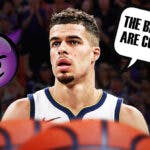Following a win on February 28, Los Angeles Lakers superstar LeBron James lamented the continued absence of fans at Staples Center.
“It just gives you an extra boost,” he told reporters. “I would love for us to start having fans here in California, especially here at Staples. It would just add so much for us.”
It was far from the first time James has bemoaned the lack of spectators since the pandemic began. Last March, days before the 2019-20 season was suspended, James hastily shot down the notion of doing his job if the fans couldn’t witness him hoop in person.
“I ain't playing,” he declared. (Four days later, he revised that stance.)
In the bubble, James admitted to struggling with the foreign feeling of performing for nobody. Of course, he quickly re-calibrated and earned his fifth Finals MVP.
This season, when the condensed schedule and short offseason have been especially taxing, the Los Angeles Lakers have sorely missed the energy provided by the usual 19,000 bodies in the building.
It's conceivable that the cavernous Staples Center — designed for mega-concerts and mass entertainment events as much as basketball — is as non-ideal for fan-less events as any NBA venue. It's exceptionally spacious, with extremely high ceilings and an eerie interior vastness. There is a jarring amount of negative space to fill.
In normal times, Staples creates a uniquely buzzy atmosphere for Lakers games, defined by Hollywood star-power and theatrical lighting. Strong attendance contributes plenty of crowd noise, while iconic imagery — courtside Lakers Girls, Lawrence Tanters' baritone, spotlighted retired numbers and banners looming above, purple-and-gold sprinkled everywhere — produce the snazziest vibe in basketball.
This season, despite admirable efforts to enliven the atmosphere, the place feels hollow by all accounts. Lakers DJ Jeremy Roueche told The Ringer that games have felt like “a scrimmage where nobody is allowed in.”
“It’s as eerie as an abandoned warehouse,” Bill Plaschke wrote for the Los Angeles Times. “The weirdness begins the minute you walk into the mostly deserted building and feel the chill … No fans means no body heat to counteract the ice that is several inches under the hardwood, and that means cold … The building feels huge, and the emptiness is pervasive.”
Consequently, Jared Dudley said the bench has tried to compensate with animated cheerleading to provide a pick-me-up.
““It’s literally lifeless,” Dudley told Plaschke about Staples. “It’s a big deal for us personally to bring super-tough energy to the gym, pumping the guys up, screaming, running on the court, talking nonstop. We have to re-create what is missing in the stands. … You can hear a quarter drop.”
James has relied on his imagination. During a February 12 game against the Memphis Grizzlies, James nailed a step-back triple to end the third quarter, which would normally have sent the Lakers faithful into a frenzy. Before heading to his sideline, he raised his arms as if to fire up the non-existent crowd.
Step-back three at the buzzer!
Bron in the zone 👑 pic.twitter.com/RJ6wUOI5Dp
— ESPN (@espn) February 13, 2021
“I’m definitely imagining our fans being in the building,” he said afterward. “It’s just not the same without them. I miss our fans a lot. There's a lot of momentum plays that happen in a game where a team calls timeout, or at the end of the quarter, and you know fans are going to be up.”
Reluctantly, James has changed his tune from last year and has seemed to reach the fifth stage of grief: acceptance.
“I’m embracing the norm of what’s been going on lately,” he said post-Grizzlies win. “I’ve embraced that, but also at the same time I still miss the regular thing I grew accustomed to over my career … There's so many different outcomes and feelings you would have if fans weren’t involved. I will never not miss the fans.”
Looking ahead to the second half and postseason run, when can LeBron expect to see friendly (and noisy) faces in the Staples Center seats? Let's review.
In November, Staples Center announced that no fans would be permitted “until further notice.”
By the end of March, over half the league will allow fans in a limited capacity, but none of the California franchises have yet to formally announce plans.
At this moment, most of California remains in the “purple tier” of COVID-19 restrictions. But a few major counties, including L.A., could soon upgrade into the “red tier” as reported daily cases decrease. Once in the red, larger capacity outdoor venues, like amusement parks, can welcome patrons again at a limited capacity.
Last week, the California department of public health announced that fans can attend MLB games when the season opens. The Los Angeles Dodgers are hopeful that tickets could be administered to up to 11,200 fans for the April 9 home opener, per the Los Angeles Times.
Promisingly, a source told AllClippers.com that Staples is hoping to allow limited fans “a few months from now, in time for the playoffs.” President Biden has announced plans to distribute enough vaccines for all adults by the end of May, which could conveniently align with the May 16 regular-season finale.
It's hard to prognosticate precisely how much the presence of fans will help the Lakers repeat. As The Ringer's Paolo Uggetti noted, teams without fans have won about 52 percent of their home games this season (as of Feb. 26), down from the near .600 win percentage of home teams from 2000-17. Teams with limited fans have won about 56 percent of home games in 2020-21, per ESPN's Kevin Pelton.
The Lakers have been more successful on the road (13-5) than at home (11-8), but they were last season, too. James' production has been roughly the same regardless of venue.
Beyond the results, though, the players clearly feel the anecdotal toll of pumping themselves up.
“What is the word ‘sport' without ‘fan'?” James asked on Spectrum's Road Trippin'. “There's no excitement. There's no crying. There's no joy. There's no back-and-forth…That's what also brings out the competitive side of the players, to know that you're going on the road in a hostile environment and yes, you're playing against that opponent in front of you, but you really want to kick the fans' ass too.”
“I miss that interaction. I need that interaction,” James said after his memorable spat with “Courtside Karen” in Atlanta on Feb. 1. A few days prior, he lit up the Cleveland Cavaliers in the fourth quarter, motivated by the cackling of a front office executive.
The Lakers have claimed not to care about home-court advantage, but one has to assume they would benefit from authentic crowd energy on their repeat quest, especially as their opponents continue welcoming fans back.
Furthermore, there are ramifications beyond this season. The Lakers may be the fourth-most valuable franchise in sports, per Forbes, but that means nothing unless the Buss family sells the team.
More pertinently, as one of the few remaining “mom-and-pop” franchises that aren't backed by a deep-pocketed mega-billionaire or new money tech guru, the Lakers heavily rely on cash flow — much of which comes from gate receipts. In fact, the Buss Family Trust is ranked just 19th among most valuable “sports empires”, according to Forbes.
If the Lakers want to extend Dennis Schröder and re-up Alex Caruso and Talen Horton-Tucker — not to mention retaining Montrezl Harrell — and maximize their championship window, they'll have to eat a massive $100 million+ luxury tax bill.
The fewer fans walking through that door, the less feasible that becomes, even with an 18th banner.




